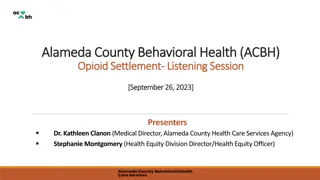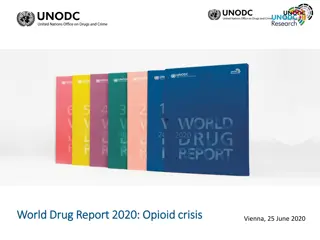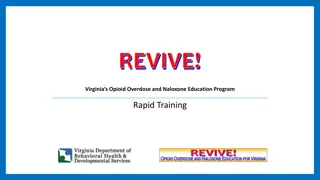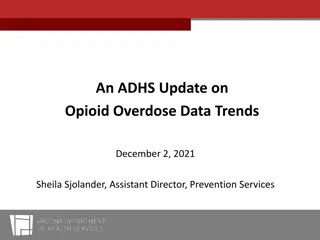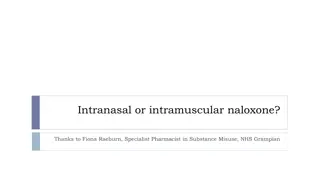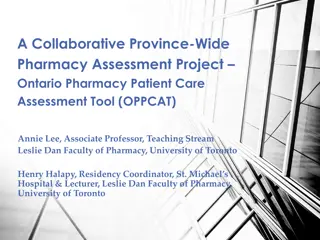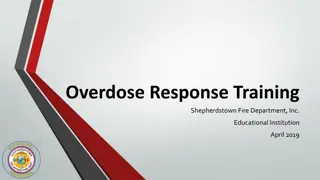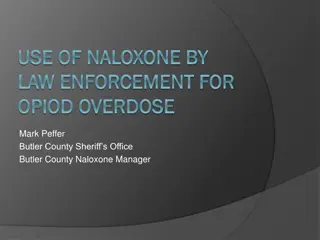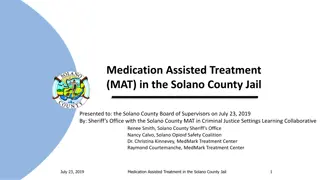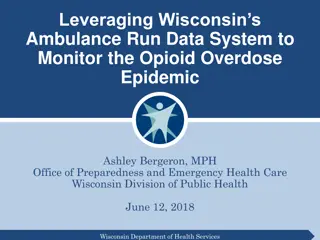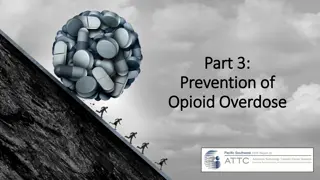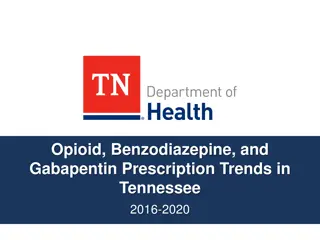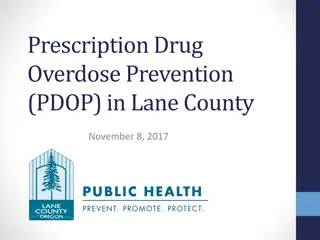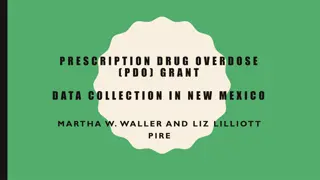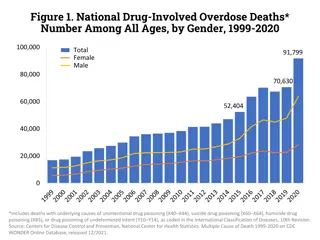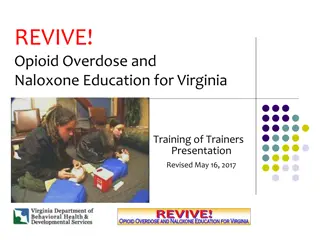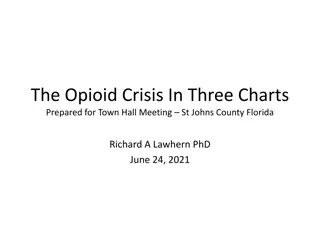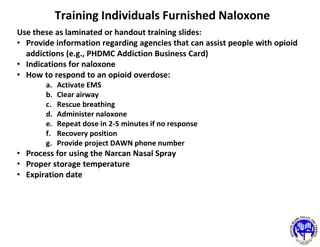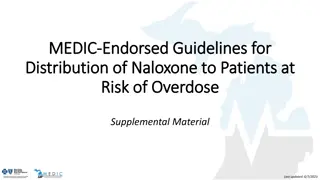Opioid Overdose and Prevention in Ontario
Accidental overdoses pose a significant threat in Ontario, with opioids impacting young adults profoundly. The presentation covers the alarming rates of opioid-related deaths, signs of overdose, management strategies, and the role of Take-Home Naloxone kits in saving lives. It also delves into the Provincial Narcotic Strategy, different types of opioids, and factors contributing to overdose risks.
Download Presentation

Please find below an Image/Link to download the presentation.
The content on the website is provided AS IS for your information and personal use only. It may not be sold, licensed, or shared on other websites without obtaining consent from the author. Download presentation by click this link. If you encounter any issues during the download, it is possible that the publisher has removed the file from their server.
E N D
Presentation Transcript
Presentation to HSJCC November 1st, 2016 1
1. Discuss Take-Home Naloxone kits 2. Describe the P4P program 3. Explain the Paperless Drug Card Initiative 2
Discuss briefly rates of opioid overdose Recognize signs and symptoms of opioid overdose Management of an opioid overdose Understand role of take home Naloxone Identify resources for Naloxone training 4
Accidental overdoses are the 3rd leading cause of unintentional death in Ontario - a comparable figure to traffic fatalities Oxycontin and other opioids tied to 1 in 8 deaths in young adults (Ontario study) Prescriptions for high-dose opioids on rise (Canadian study) 6
Provincial Narcotic Strategy in 2010 included harm reduction programs 2012 Oxycontin (Opioid) discontinued March 2012 - Ministry of Health and Long- Term Care (MOHLTC) created Expert Working Group on Narcotic Addictions 7
Natural opioids: contained in resin of opium poppy (morphine, codeine) Semi-synthetic opioids: created from natural opioids such as hydromorphone, hydrocodone, oxycodone, heroin etc., Fully Synthetic Opioids: Methadone, Fentanyl 8
Patient factors Loss of tolerance Comorbidities Previous overdose Using alone Opioid factors (prescribed and non-prescribed) Dose Potency Contaminants Routes of administration Polysubstance use 13
Rarely instantaneous Can happen 1-3 hours after use Body has ingested more than it can handle Opioids attack receptors that control breathing Oxygen can t get to the brain Heart stops Unconscious, Coma, Death Long-term Brain/Nerve/Physical Damage 14
Opioid Antagonist Medication that reverses only OPIOID overdose Can not get high on it Can not abuse it Stays active for 20-90 minutes depending on metabolism, amount of drug used 15
Health Canada rescheduled to Schedule 2 (OTC) March 22 2016 Ontario Schedule II, available free through pharmacies Available through numerous harm reduction sites Schedule 2 because training needed for administration of medication Currently only IM formulation currently available in Canada Ampoules or vials Intranasal formulation coming soon http://www.ccsa.ca/Resource%20Library/CCSA-CCENDU-Take-Home-Naloxone-Canada-2016-en.pdf 16
1. Recognizing OD 2. CALL 911 3. Prepare/administer naloxone 4. Aftercare 17
REALLY HIGH OVERDOSE Shallow/no breathing Vomiting/gurgling Skin cold/Pallor Blueing under fingernails UNRESPONSIVE Pain sternal rub Auditory stimuli yelling their name Shaking their shoulders Muscles become relaxed Deep snoring or gurgling (death rattle) Speech is slowed/slurred Very infrequent or no breathing Sleepy looking Pale, clammy skin Nodding Heavy nod Will respond to stimulation like yelling, sternal rub, pinching, etc. No response to stimulation Slow heart beat/pulse 18
Naloxone 0.4mg/mL ampoules Minimum 2 in a bundle Minimum 6 month expiry date Safety syringes (3mL x 25ga) Unlikely to be used for anything else Reduced risk of needle-stick injury Nitrile gloves Breathing mask Alcohol swabs Ampoule breakers 21
Spin/Open ampoule Use alcohol swab if needed Prepare syringe Draw up all contents of 1 ampoule Inject into thigh, buttocks or shoulder Fully depress the plunger of safety syringe Needle retracts into barrel Evaluate Continue to give breaths Re-administer q5mins if not working 22
When the person wakes up Stay with them until ambulance arrives They will likely be confused - explain that they overdosed Do not let them use more substances Withdrawal symptoms will dissipate rapidly Be prepared to give more naloxone if necessary 23
Fear of legal risk (outstanding warrants, DSS involvement, loss of public housing) Fear of judgment from family/ community Personal embarrassment/shame Other punitive measures (students loose financial aid) Urban legends (homicide charge for being at an OD, being deported) 24
Dont use alone Have a partner Larger groups; have a sober guide ( trip sitter ) Limit drug use until potency known First hits are small ( or of normal quantity) Limit polysubstance use Have naloxone available 25
Fast tracked by Health Canada Provincial regulators now looking at scheduling $125 USD per 2 devices? 26
The Works, Toronto Public Health: 277 Victoria St 27
Person who is either currently using opioids Past opioid user who is at risk of returning to opioid use Person who abuse prescription opioids or heroin Patients who have required emergency care for opioid overdose Persons enrolled in opioid dependence treatment programs Persons with a history of opioid dependence or abuse who are being released from prison Patients receiving prescription opioid therapy with risk factors for adverse effects Family member or friend of someone at risk of opioid overdose Persons living with or in frequent contact with those listed above
www.opatoday.com/professional/resources/forpharmac ists/tools-and-forms/naloxone Ontario Public Drug Programs Division Updates Naloxone June 29, 2016: https://www.opatoday.com/professional/resources/pub lications/OPDPJune29-July5#opdp16076 30
Collaboration among physicians, pharmacists and patients Promotes safe, effective, responsible use of Fentanyl Goal is to decrease the number of overdoses related to Fentanyl misuse 32
Synthetic Opioid analgesic Several fentanyls, salts, derivatives, analogues Rapid acting Potent Controlled drug Therapeutic uses 33
Prescribed Often unsafe Diversion Uncontrolled Often imported Powder, tablets, mixed Friesen et al CMAJ Apr 4 2016 and CCENDU Bulletin August 2015 34
Street names Apache, China Girl, China White, Dance Fever, Friend, Goodfella, Jackpot, Murder 8, TNT and Tango and Cash Street Prices(per patch) 35
Motor vehicle deaths (2014) 481 Streptococcus pneumoniae 623 Opioid-related (2014) as per Office of the Chief Coroner, Ontario 673 http://www.mto.gov.on.ca/english/publications/pdfs/preliminary-2014-orsar -selected- statistics.pdf http://www.publichealthontario.ca/en/eRepository/ONBoID_ICES_Report_ma18.pdf Office of the Chief Coroner, Ontario 39
Prescription monitoring programs Decrease in prescriptions highly suggestive of misuse (1.6% to 1.0%, 2011 to 2013) Oxycodone delisting Decrease in oxycodone dispensing Increase in other opioid prescribing Physician education Media reporting Murphy Y, Goldner EM, Fischer B. Prescription Opioid Use, Harms and Interventions in Canada: A Review Update of New Developments and Findings since 2010. Pain Physician. 2015 Jul-Aug;18(4):E605-14. Gomes T, Juurlink DN. Opioid Use and Overdose: What We've Learned in Ontario. Healthc Q. 2016;18(4):8-1 40
It is a one in, one out model, where patients are asked to return any patches previously dispensed to them back to the pharmacy before they are able to receive more. Patch disposal sheet provided to patient Prescribing physicians are requested to limit prescriptions to a 30 day supply (typically 10 patches). 41
O When D Who B How Common Questions 42
The Ministry of Community and Social Services (MCSS) is improving service delivery to social assistance clients by enabling them to use their Ontario health card to access the Ontario Drug Benefit (ODB) program to get their prescription medicine, rather than issuing them with a monthly paper drug card for this purpose . 43
Transition period Clients will be able to use their OHIP card to enable them to get their prescription medication. Clients will still receive their monthly paper drug card during this period and may continue to use the paper drug card to get their prescription medication. The transition period will allow time for Clients who are not in possession of a valid Ontario health card, to obtain a new or replacement card before full implementation Pharmacies and clients to adjust to the new process. BUT .. As of December 2016, social assistance clients will no longer receive a monthly paper drug eligibility card. 44
All social assistance clients who are recipients of: Ontario Disability Support Program (ODSP) Plan C Assistance for Children with Severe Disabilities (ACSD) Program Plan C Temporary Care Assistance (TCA) Program Plan D Ontario Works Program (OW) Plan D This also includes First Nations clients managed by ODSP and Ontario Works delivery agents. 45
Pharmacies will use the social assistance client s Ontario health card to process claims through the Health Network System (HNS) for reimbursement. Help Line toll-free at 1-888-284-3928 for verification
How does the OHIP authorization actually work? Social Assistance Management System (SAMS) to Ministry of Health and Long- Term Care (MOHLTC) Ontario Drug Benefit (ODB) interface containing social assistance client eligibility information. Pharmacist validates coverage via HNS Interface is updated daily (new and terminated) and monthly (entire social assistance caseload) Possible errors? health card number error service provided before effective date coverage expired before service no record of beneficiary patient not covered by this plan can result in delays in updated information in HNS upwards of 72 hours What happens if someone s assistance is cancelled/suspended? SAMS network will provide information to pharmacist
Does the drug coverage end immediately upon the suspension? Drug coverage will end on the last day of the month, prior to the effective month of suspension Example: suspension in SAMS on October 14, drug coverage continues till October 31st and suspended November 1st REASON = EQUITY BETWEEN THE TWO CLIENTS Currently, an ODSP client whose case is suspended, or terminated, will receive a drug card for the month following the last month of eligibility. Example: if a case is suspended or terminated effective November 1, the client will still receive a drug card for November, even though there is no eligibility - because ODSP issues income support retroactively at the end of the month, and the drug and dental cards are also issued at the end of the month but for the following month In contrast, Ontario Works currently issues both financial support and benefit cards at the beginning of the month, for that month. There is no change to the way Ontario Works cases will be treated
If there is an appeal, how does the drug coverage get reinstated during the appeal if interim assistance is granted? The caseworker would indicate in SAMS that interim assistance has been granted and drug coverage would be reinstated along with the case. The change would be reflected in the SAMS to MOHLTC ODB interface, which would subsequently provide data to the HNS. If someone loses their OHIP card, how quickly can a paper drug card be issued? If necessary, ODSP/Ontario Works staff can issue a manual paper drug card right away and it can be faxed to the pharmacy, per the current process
If someone travels and needs to use their health card, does their social assistance status then become known? Does their travel become known by ODSP/Ontario Works? If a client is travelling within Ontario, then the client can use his/her Ontario health card anywhere in the province to access prescribed drugs without having to pay and pharmacists can see that the client is eligible for ODB. If the HNS responds with an error code, pharmacists have to contact the Social Assistance Verification Help Line to verify the client is in receipt of social assistance for the period in question. Clients cannot access Ontario health coverage using their Ontario health card or social assistance drug eligibility card outside of the province of Ontario. There is also no access to the HNS for pharmacists outside Ontario. ODSP/Ontario Works staff do not track the usage of the Ontario health card as a way to monitor travel. If the client needs assistance with medical travel, he/she will need to obtain prior approval from their caseworker by completing a Mandatory Special Necessities Form

 undefined
undefined








